If you ask someone the question “which function drives innovation in a company?”, the most likely response will be R&D. After all, R&D spends the most time on inventing and improving products. But as you start digging deeper, additional responses will be Marketing, Supply Chain, Engineering, and Information Technology drive innovation. One department that does not often come up in the list is Human Resources. But HR has a massive impact on innovation – much more than people realize. So let’s understand how Human Resources can drive innovation?
Borrowing from the Week’s podcast episode
In this week’s podcast, I discussed insights from management science research on radical innovations. One of the key lessons from the podcast was about absorptive capacity. We talked how radical innovations are challenging because firms lack the needed absorptive capacity. In fact, when a firm gets disrupted by a radical innovation, the cause often is the lack of appropriate absorptive capacity.
Absorptive Capacity
Absorptive capacity refers to a firm’s ability to value new information, assimilate it and use it for commercial purposes. To understand it, consider how learning takes place. It is associative and cumulative. To understand an advanced concept in stochastic calculus, one has to understand basic algebra. To understand financial engineering, one needs basic math.
Visualize how water falls on a piece of marble. The stone does not absorb even a drop. On the other hand, imagine water falling on kitchen paper. The paper readily absorbs water. If new information enters a firm, but the firm cannot value it, assimilate it and use it, the absorptive capacity of the company is almost nil for that kind of information.
Effects of a Lack of Absorptive Capacity
So when a firm is devoid of basic knowledge in an area, it will not be able to make sense of incoming information in that field. It will remain a bystander until its business begins to get affected. I gave several examples of this phenomenon in the podcast this week. When EMI invented X-rays, GE and Picker couldn’t compete with EMI because they lacked the basic knowledge of algorithms needed to build CT scanners.
Two Dimensions of Absorptive Capacity
It is evident that to innovate in any space, you need to be able to connect the dots. But you can connect the dots in two different ways. One involves deepening of knowledge where the connecting of dots takes place with ever increasing depth. For example, a a process owner improves a process with deeper understanding over time. The second one includes broadening of knowledge. While a deepening of knowledge creates ideas within a narrow area, broadening of knowledge allows one to connect the dots across areas. For example, Hounsfeild connected the dots between X-rays and algorithm knowledge from radars and missile guided systems to invent the CT scanner technology.
Job Rotation and Absorptive Capacity
Job rotation policy is an excellent way to direct the kind of absorptive capacity an organization creates. As a result, it determines the kind of innovations the organization will produce. Job continuity will lead to deeper knowledge and deeper absorptive capacity within a narrow area. This is ideal for incremental innovations. Job rotation, on the other hand, will lead to broadening absorptive capacity. It allows people to connect the dots across areas. It results in different kinds of innovations.
Knowledge Structures and Absorptive Capacity
Job rotation also leads to a better understanding of knowledge structures within a firm. Knowledge structures is the meta knowledge of a firm’s knowledge – who knows what and where. It allows an employee to get access to knowledge stored with different people. It is through knowledge structure that an organizational level absorptive capacity arises.
How Human Resources Can Drive Innovation?
In short, job rotation and job continuity policies and practices can lead to different levels and types of absorptive capacity in an organization. A second level outcome of this policy is different kinds of innovations. And this is just one example of how HR drives innovation in meaningful ways.





Please note: I reserve the right to delete comments that are offensive, or off-topic. If in doubt, read my Comments Policy.